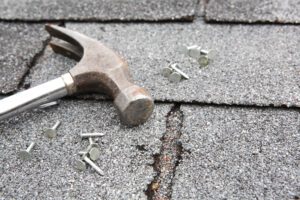
10 Most Common Roof Repairs to Watch Out For
Roof repairs are an inevitable part of homeownership. Over time, the elements, wear and tear, and other factors can damage your roof, which serves as the primary barrier between your home's interior and the outside world. Being proactive about identifying issues can save you thousands in potential water damage or more extensive roof repairs down the line. Here's a list of the 10 most common roof repairs to keep an eye out for:
- Shingle Damage: This is perhaps the most visible of all roof problems. Over time, shingles can get cracked, warped, or even go missing due to wind, rain, or simple deterioration. Shingle replacement is a basic repair, but it's crucial to address it early to prevent underlying damage.
- Flat Roof Blisters: Bubbles or blisters can form on flat roofing when there is trapped moisture or air under the roofing material. They can lead to more significant issues if not dealt with promptly.
- Flashing Repairs: Flashings are thin strips of metal installed at danger points for leaks on a roof (e.g., around the chimney, vents, or skylights). If they start to pull away, rust, or break, water can seep in, leading to leaks.
- Valley Leaks: Valleys (where two roof slopes meet) are particularly susceptible to leaks. If not sealed correctly, water can get trapped and start to seep through.
- Gutter and Downspout Issues: Gutters play a crucial role in directing water away from your home's foundation. When they get clogged, leak, or don't drain properly, they can spill water down your siding or into your home's foundation.
- Sagging Roof Deck: If the structural integrity of the beams and rafters supporting your roof is compromised, it might lead to a noticeable sag in the roof deck. It's a severe issue that often requires significant repairs.
- Ventilation Issues: Roof vents prevent humidity buildup, ensuring the air in the attic circulates properly. If they get blocked or damaged, it can lead to a host of problems, from mold and mildew to weakened shingles.
- Skylight Leaks: Skylights brighten up your home but can be a weak point for leaks. If the seal around a skylight is damaged or it wasn't installed properly, it can start to drip or show condensation.
- Chimney and Chimney Flashing Damage: Like roof vents, chimneys are a common site for roof leaks. If the sealant around the chimney starts to crack or pull away, or if the chimney structure itself is compromised, it can lead to leaks.
- Ice Dams: These occur when snow on the roof melts, flows to the edge, and refreezes, blocking the gutter. Water can then pool behind the dam and leak into the home.

Proactive Measures Are Key
The best way to handle potential roof issues is through regular inspections and maintenance. It's advisable to inspect your roof twice a year – once in the spring and once in the fall. Additionally, after significant storms, a quick check can help identify and address problems early on.
If you notice any signs of damage, it's essential to get them addressed as soon as possible. Even minor issues can quickly become major problems if water starts seeping into your home. A qualified roofing contractor can provide assessments and estimates, ensuring your home remains safe and dry for years to come.
Top Maintenance Tips to Prevent Roof Damage
Roofs are an essential part of a home or building's structure, and they bear the brunt of environmental and weather conditions. With proper care and maintenance, you can significantly extend the lifespan of your roof and stave off the need for major repairs. Here are some top maintenance tips to help you keep your roof in the best possible condition:
Check for Debris Regularly
Over time, debris such as leaves, branches, and dirt can accumulate on your roof, especially in valleys and low spots. This debris can trap moisture, which, over time, can damage roofing materials. Cleaning your roof of debris regularly prevents moisture buildup and potential mold growth.
Inspect for Moss and Algae Growth
Moss and algae thrive in shaded and damp conditions. Not only are they unsightly, but they can also damage shingles and lead to leaks. If you notice moss or algae growing on your roof, consider installing zinc or lead control strips.
Clear Gutters and Downspouts
Clogged gutters can cause water to overflow, leading to foundation and siding damage. Ensure that your gutters and downspouts are clear of debris, particularly during fall when leaves tend to accumulate. This ensures proper water drainage away from your home.
Trim Overhanging Branches
Tree branches can scrape against shingles, stripping away their protective layer. Additionally, in the event of a storm, these branches can break off and cause significant damage. It's best to trim any overhanging branches to prevent these issues.
Ensure Proper Ventilation
A well-ventilated attic can prevent many roof-related problems by reducing heat buildup during the summer and preventing moisture buildup during winter. Ensure that your roof vents are clear and in working order.

Regular Professional Inspections
While DIY maintenance is crucial, having your roof professionally inspected at least once a year can help spot potential problems that might not be visible to the untrained eye. Professionals can provide actionable advice and solutions.
Address Minor Repairs Promptly
If you spot any damage, no matter how minor, it's crucial to address it immediately. Small problems, if left unchecked, can quickly escalate into more significant, more costly issues.
Seal Any Roof Penetrations
Roof penetrations, like chimneys, vents, and skylights, can be vulnerable to leaks. Ensure that they are well-sealed and check the sealant or flashing regularly for signs of wear or damage.
Check for Signs of Animal Damage
Squirrels, raccoons, and other animals can sometimes cause damage to your roof, either by gnawing on materials or by building nests. If you notice any signs of animal activity, it's essential to address the issue quickly to prevent further damage.
Know Your Roof's Lifespan
Different roofing materials have different lifespans. Knowing how long your type of roof is supposed to last can help you anticipate problems and plan for eventual replacement.
By following these maintenance tips and being proactive in your roof care, you can protect your investment, prolong the life of your roof, and avoid costly repairs down the line.

How Long Does a Roof Last?
The lifespan of a roof largely depends on the type of material used, the quality of the installation, and the environmental factors it's exposed to. While roofs are designed to be durable and withstand the elements, they are not immune to wear and tear. Here's a breakdown of how long you can expect different types of roofs to last, both in terms of repairs and total replacement:
Asphalt Shingles
These are the most common roofing materials for residential homes.
- Life expectancy for repairs: Typically, you might begin to see the need for minor repairs after 12 to 15 years, especially if the roof was not optimally installed or maintained.
- Total replacement: A well-maintained asphalt shingle roof will generally last between 20 to 25 years, though top-quality shingles might extend that lifespan up to 30 years.
Metal Roofs
Metal roofs are gaining popularity due to their durability and modern look.
- Life expectancy for repairs: With proper maintenance, minor repairs might be needed after 30 to 40 years.
- Total replacement: Metal roofs can last between 40 to 70 years, depending on the type of metal used and the quality of installation.
Tile and Slate Roofs
These materials are incredibly durable and can give a timeless appeal to your home.
- Life expectancy for repairs: Minor repairs might start cropping up after 40 to 50 years.
- Total replacement: Tile and slate roofs can last between 50 to 100 years, or even longer with meticulous care.
Wood Shingles and Shake
Wood offers a classic and natural aesthetic to homes.
- Life expectancy for repairs: You might begin to see the need for minor repairs after 15 to 20 years.
- Total replacement: On average, wood shingle roofs have a lifespan of about 20 to 30 years. However, cedar shakes, being thicker than shingles, can last up to 40 years with proper care.
Flat Roofs
Common for commercial buildings, flat roofs have their own set of maintenance needs.
- Life expectancy for repairs: Initial repairs for flat roofs typically start appearing around the 10-year mark.
- Total replacement: Flat roofs, depending on the material (like PVC, TPO, or EPDM rubber), usually last between 15 to 25 years.

Factors Influencing Lifespan
While the above gives a general idea, individual roof longevity can vary based on:
- Environmental Conditions: Harsh climates with frequent storms, high winds, or dramatic temperature fluctuations can reduce the life expectancy of your roof.
- Maintenance: Regular inspections and timely repairs can significantly prolong the life of any roofing material.
- Quality of Installation: Proper installation plays a pivotal role in how long a roof lasts. Improper installation can lead to premature aging and reduced lifespan.
Understanding your roof's projected lifespan and being proactive in its care can save you significant time and money in the long run. Regular inspections and maintenance can help ensure that your roof reaches or even exceeds its expected life.
Identifying the Best Roofing Material for Your Climate
The longevity and performance of your roof are influenced not just by its quality and maintenance, but also by the climate in which your property is located. Choosing the right roofing material that suits your climate can significantly decrease the potential for damage and prolong the roof's lifespan. Here's how to identify the best roofing materials based on various climatic conditions:
For Hot and Sunny Climates
1. Metal Roofing: In areas that experience high temperatures and strong sun, metal roofs are an excellent choice. They reflect sunlight and dispel heat more efficiently than other materials, ensuring that your home remains cooler. Moreover, they don't deteriorate under UV rays as quickly as some other roofing materials might.
2. Clay and Concrete Tiles: These materials are particularly prevalent in Mediterranean and desert climates. They can resist heat and do not fade easily under direct sunlight. Their curved shape also allows for effective ventilation.
For Cold and Snowy Climates
1. Slate Roofing: One of the most durable materials, slate is resistant to freezing temperatures and can effectively withstand heavy snowfall. Its smooth, flat surface also reduces the chances of snow accumulation.
2. Asphalt Shingles: Being waterproof and sturdy, asphalt shingles can handle cold climates well. They are especially good for areas with frequent snowfall since the snow tends to slide off rather than accumulate.
For Areas Prone to Heavy Rainfalls or Humidity
1. Metal Roofing: Metal roofs, especially those with a standing seam, prevent water penetration, making them ideal for wet climates. They are also resistant to rust, ensuring longevity even in consistently rainy conditions.
2. Rubber Roofing: Especially common for flat roofs, rubber materials are waterproof and can keep moisture out, making them perfect for humid areas.
For Windy and Coastal Areas
1. Metal Roofing: Properly installed metal roofs can withstand wind speeds of up to 140 mph. They are also resistant to the corrosion that can be caused by salt in the air in coastal regions.
2. Wood Shingles or Shakes: Wood can endure salt air and is resistant to wind damage. However, they require maintenance to prevent moisture damage in these areas.

For Areas with Varied Conditions
1. Composite Shingles: Made from a combination of materials like asphalt, tar, and other items, these shingles are designed to withstand varied climatic conditions.
2. Asphalt Shingles: Their versatility makes them suitable for regions that experience a mix of sun, rain, snow, and wind. They are both durable and cost-effective.
Understanding the specific needs of your climate can drastically affect the lifespan and performance of your roof. It's essential to consult with local roofing professionals who have a deep understanding of the regional weather patterns and can guide you in choosing the best material for your property. With the right choice, you can ensure that your roof remains robust and serves its purpose for many years to come.
Estimating the Cost of Roof Repairs
Roof repairs are inevitable. Whether due to age, environmental factors, or unexpected incidents, almost every homeowner or property manager will face the need to repair their roof at some point. But one of the most pressing questions that arise when considering roof repairs is: How much will it cost? While the exact cost can vary based on several factors, we can provide a general overview to help you anticipate and budget for potential expenses.
Factors Influencing Roof Repair Costs
- Type of Roofing Material: Different materials come with varied costs. Asphalt shingles, for instance, are generally less expensive to repair than wood, metal, or tile.
- Extent of Damage: A few missing shingles might only require a minor repair job. In contrast, structural damage or widespread water leakage will undoubtedly cost more due to the complexity and extent of repairs needed.
- Location: Prices can vary depending on where you live. Urban areas or regions with a higher cost of living might see steeper roof repair costs than other regions.
- Labor Rates: The cost of labor varies between contractors and regions. It's always a good idea to get multiple quotes to ensure you're getting a competitive rate.
- Accessibility: If your roof is particularly steep or hard to access, it might increase the labor time and therefore the cost.

Average Roof Repair Costs
- Minor Repairs: For small areas of damage or a handful of missing shingles, costs can range from $100 to $400.
- Moderate Repairs: For moderate damage, such as a few leaks or a section of damaged roofing, the price might range from $400 to $1,000.
- Major Repairs: Significant damage, like extensive leaks, rotten wood, or structural damage, can run from $1,000 to $3,000.
- Complex Repairs: For extensive damage that requires replacement of a large section of the roof or specialized materials, costs can exceed $3,000 and depend largely on the specifics of the job.
Additional Considerations
- Roof Inspections: Before any repairs, it's advisable to have a thorough roof inspection. Some professionals offer free inspections, while others might charge between $100 and $300. An inspection can give you a clear picture of what repairs are necessary and provide a more accurate estimate.
- Preventative Maintenance: Sometimes, investing in preventative maintenance can help avoid more significant repairs down the line. This might include things like sealing small leaks, replacing damaged shingles promptly, or ensuring proper attic ventilation.
- Insurance: Depending on the cause of the damage, your homeowner's insurance might cover part or all of the repair costs. It's worth reviewing your policy and speaking with your insurance agent to understand your coverage.
While the cost of roof repairs can vary widely based on several factors, having a general idea of potential expenses will help you plan and budget accordingly. Regular inspections and maintenance can also go a long way in preventing small issues from turning into costly problems.

Choosing a Roofing Contractor for Repairs
After recognizing the need for roof repairs and understanding the potential costs, the next logical step is selecting a roofing contractor. Your choice of contractor can significantly influence the quality of repairs, the cost, and the longevity of your roof. Here's a guide to help you make an informed decision.
1. Research and Recommendations
Start with a basic online search to identify roofing contractors in your area. Read reviews, and don’t hesitate to ask friends, family, or neighbors for recommendations. Personal testimonials can often provide the most reliable insight into a contractor's work quality and professionalism.
2. Check Licensing and Insurance
Ensure any contractor you consider is licensed to work in your state and carries both workers' compensation and liability insurance. This protects you from potential legal issues if an injury occurs on your property during the repair process.
3. Ask About Experience
Experience can be a good indicator of a contractor's skill and reliability. While newer companies might offer competitive prices, they may lack the practical experience of more established businesses. However, this doesn't mean newer companies can't provide excellent service; it's just another factor to consider.

4. Get Multiple Quotes
Before settling on a contractor, it's wise to obtain multiple quotes. This will give you an understanding of the average cost for your repairs and help you identify any outliers. Remember, the cheapest option isn't always the best. Quality work often comes at a price, but it can save money in the long run by preventing future issues.
5. Ask About Warranty
Reputable contractors usually offer a warranty on their work. This warranty can range from a few months to several years. It's crucial to have a clear understanding of what's covered under the warranty and for how long.
6. Discuss Timeline
If you're dealing with a leak or any other urgent issue, you'll want repairs done quickly. Discuss the timeline with potential contractors to ensure they can start and complete the job within your desired timeframe.
7. Communication is Key
Pay attention to how responsive a contractor is during your initial interactions. Reliable communication is crucial for ensuring the job goes smoothly. If they’re slow to respond to your inquiries now, they might be just as slow once the project begins.
8. Review Contract and Payment Terms
Once you've chosen a contractor, carefully review the contract before signing. Ensure it includes specifics about the job, materials, costs, and timeline. Understand the payment terms: while many contractors require a deposit, be wary of those demanding full payment upfront.
Your roof is a vital part of your home's structure, and maintaining it is crucial for your home's overall health. While the prospect of repairs can be daunting, a reliable and professional contractor can make the process smoother and ensure quality work. Taking the time to choose the right contractor for the job will give you peace of mind and protect your home investment.

Leave a Reply